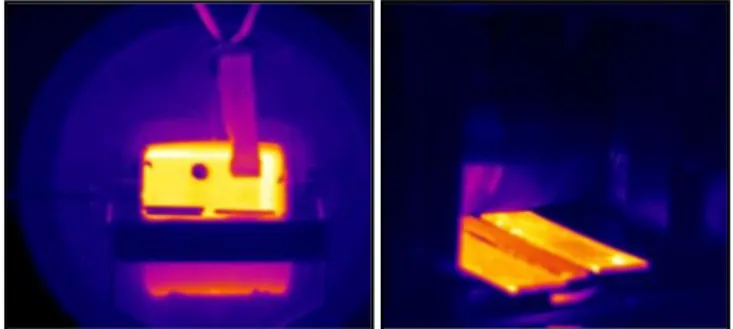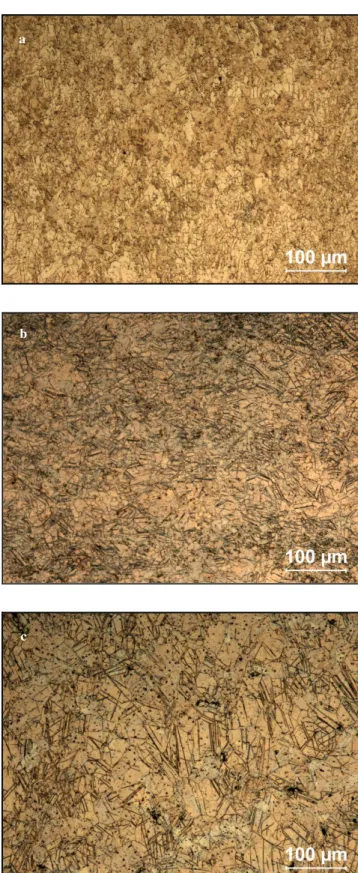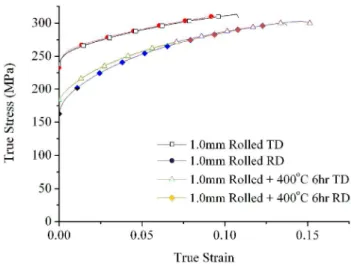DEVELOPMENT OF ROLLING TECHNOLOGY FOR
TWIN ROLL CASTED 1500MM WIDE MAGNESIUM AZ31 ALLOY
Ozgur Duygulu1, Selda Ucuncuoglu1, Gizem Oktay1, Deniz Sultan Temur1, Onuralp Yucel2 and Ali Arslan Kaya1,3
1
TUBITAK MRC, Materials Institute, P.O.B. 21, Gebze, Kocaeli 41470, TURKEY 2
Istanbul Technical University, Department of Metallurgical and Materials Engineering, Istanbul 34469, TURKEY 3
(Currently) Mugla University, Engineering Faculty, Department of Metallurgy and Materials, Kotekli, Mugla 48000, TURKEY
Keywords: Magnesium alloy, Twin roll casting, Rolling, AZ31.
Abstract
Magnesium alloy AZ31 sheets of 4.5-6.5mm thick and 1500mm width were produced by twin roll strip casting first time in Turkey. Afterwards, sheets were hot and cold rolled down to less than 1mm both by laboratory and industrial scale rolls. Microstructure of the sheet was analyzed by optical microscope and transmission electron microscope. In addition, pole figures have been obtained by XRD studies. Mechanical properties were investigated by tensile tests and also hardness measurements. Annealing heat treatments were performed on the produced sheets.
Introduction
Magnesium alloys have been considered as advanced materials for many applications, especially for transportation, aerospace and electronic industries. Other than being the lightest structural metal (density: 1.74 g/cm3), it has high specific strength, excellent damping capacity, good machinability and good electromagnetic shield properties [1]. Moreover, magnesium wrought alloys have good mechanical properties compared to other alternative traditional structural metals. There is a high demand of using magnesium alloy for transportation, aerospace and electronic industries. However, application of magnesium wrought alloy sheets for these industries is limited due to the cost of the magnesium material [2]. Decreasing the magnesium sheet prices can be met through twin-roll casting [2]. There is a wide range of application of twin-roll casting technique on magnesium alloys [3-14]
Recently, an industrial scale magnesium twin roll casting plant has been set up in Turkey. 1500mm wide magnesium alloy AZ31, AZ61, AZ91, AM50 and AM60 sheets of 4.5-6.5mm thickness have been successfully casted [15,16]. To our knowledge, these are the widest magnesium alloy sheets that have been produced by this method in the world so far. Afterwards, sheets were hot and cold rolled down to less than 1mm both by laboratory and industrial scale rolls.
Experimental Procedure
The reason for choosing AZ31 alloy in the present study is that it is the most common wrought Mg alloy. The chemical composition of magnesium alloy AZ31 sheets are listed in Table 1.
Table 1. The chemical composition of magnesium alloy sheets.
Sample Al Zn Mn Mg
AZ31 2.7 1.03 0.31 bal.
The magnesium AZ31 alloy strips were cut to 5cmx20cm size samples. Sheet samples were homogenized at 400°C. After homogenization, sheets have been warm/hot rolled using a laboratory scale rolling mill. Prior to the rolling, the rolls were heated by gas flame. The samples were preheated in a furnace for approximately 20 minutes before rolling. The temperature was controlled by a FLIR Systems ThermaCAM thermal camera and a thermocouple (Figure 1). Magnesium alloy AZ31 sheets were rolled at 300˚C with 25% deformation at a single pass. In another trial, samples were hot rolled at 450˚C and a maximum deformation amount of 50% has been reached in one rolling pass.
The experience and knowledge obtained from the laboratory scale rolling have been adjusted to industrial scale rolling. An electrical resistant furnace has been put next to 1600mm wide horizontal rolling system (Figure 2). Before rolling, homogenization heat treatment was applied on the twin roll casted Magnesium AZ31 sheets at 400ºC. Rolling procedure was performed just after heating the sheets at 400ºC in the furnace. Final sheet thickness of 1.0mm was achieved after approximately 10 passes rolling. Twin roll casting direction and rolling direction were the same orientations.
Metallographic samples were prepared to observe the microstructure in the length, width and thickness directions. The samples were mounted and polished starting with SiC paper, followed by diamond slurry and colloidal silica. Etching was done using acetic picral acid solution (4.2g picric acid, 10ml acetic acid, 70ml ethanol, 10ml water) face up for 5 seconds immediately followed by washing with ethanol. Heyn Lineal Intercept procedure (ASTM E112-96 standard) is applied for measuring the size of the grains.
In order to evaluate the deformation behavior of the AZ31B sheet, tensile tests were preformed. Tensile samples were machined via EDM (Electric discharge machining) in accordance with ASTM standard B557M. The samples were subsize specimens. A Zwick Z250 tensile testing machine at a strain rate of 1x10-3 s-1 was used for tensile testing. Vickers microhardness measurements were performed with a 200g applied load using a Zwick ZHV10 device.
For X-ray diffraction (XRD) texture studies, specimens were polished to third quarters of sheet thickness. Texture measurements were performed by PANalytical X’Pert Pro operated at 45kV and 40mA.
For transmission electron microscopy (TEM) studies, specimens were cut; 3mm diameter discs were punched and ground to a thickness less than 80µm. Punched specimens were dimple ground with Gatan 656 Dimple Grinder. Specimens were ion
Magnesium Technology 2009
Edited by: Eric A. Nyberg, Sean R. Agnew, Neale R. Neelameggham, and Mihriban O. Pekguleryuz TMS (The Minerals, Metals & Materials Society), 2009
LaB6 filament operated at 200kV.
Figure 1. Thermal camera pictures during hot rolling.
Figure 2. Photograph of industrial scale rolling mill system and furnace used for hot rolling.
Results
Homogenization heat treatments were applied on the produced Mg AZ31 sheets. As a beginning, heat treatment was performed between 350-450ºC for 1-2-4-6hr in laboratory scale furnace. Figure 5 shows plan view microstructures of TRC 6.5mm AZ31 magnesium alloys after homogenization at 350˚C, 400˚C and 450˚C for 2hr.
After laboratory scale warm/hot rolling processes the grain size of less than 10µm has been achieved in some regions as shown in Figure 4. With industrial scale rolling mills, AZ31 sheets have been rolled down to 1.0mm. Figure 5 and 6 shows three examples of the rolled sheets: 2.0, 1.5 and 1.0mm thick in the as-rolled condition from plan-view and cross-sectional views. Figure 7 shows a TEM picture of the as-rolled AZ31 sheet with lots of twins and dislocations.
Annealing heat treatments were applied to the as-rolled Mg AZ31 sheets between 350-450ºC for 1-2-4-6hr in laboratory furnace. In Figure 8, microstructures are given for three Mg AZ31 rolled sheets after homogenization heat treatments at 400ºC for 6hr. The twin structure is changed to equiaxed grains in most places. Grain sizes of less than 20µm are achieved. Homogenization processes are under investigation for longer times for industrial scale sheets.
Figure 3. Plan view microstructures of TRC 6.5mm AZ31 magnesium alloys after homogenization at a) 350˚C-2hr, b) 400˚C-2hr and c) 450˚C-2hr.
a
b
Figure 4. Light micrographs showing the microstructures after a) rolling at 300ºC, and b) rolling at 450ºC with laboratory scale rolling-mills.
Figure 9 is showing Rolling Direction, RD, and Transverse Direction, TD, sample orientations. From tensile test results of the as-rolled sheets it is observed that UTS values of 300MPa and elongation values of 10% can be achieved (Figure 10). Moreover, by the homogenization heat treatment applied to TRC 6.5mm AZ31 sheets ductility values of more than 20% elongation was achieved (Figure 11). Similar annealing heat treatments performed on as-rolled AZ31 sheets resulted to better ductility compared to the as-rolled condition as shown in Figure 12.
Figure 5. As-rolled plan view microstructures of a) 2.0 mm, b) 1.5 mm and c) 1.0 mm AZ31 magnesium alloys.
a
b
b
c a
Figure 6. As-rolled cross-sectional mictrostructural views of a) 2.0 mm, b) 1.5 mm, c) 1.0 mm AZ31 magnesium alloys (the dashed line shows the centerline)
.
Figure 7. TEM picture of as-rolled AZ31 sheet showing twins and dislocations.
Figure 8. Plan views of a) 2.0 mm, b) 1.5 mm, c) 1.0 mm AZ31 magnesium alloys after annealing at 400˚C for 6hr.
300 µm
300 µm
b300 µm
c a b c aFigure 9. Schematic picture showing sample orientations.
.
Figure 10. Flow curve of as TRC 6.5mm, and as-rolled 1.0mm and 1.5mm AZ31 sheets.
Figure 11. Flow curve of TRC 6.5mm AZ31 sheet after homogenized at 350-400-450ºC for 2hr for RD samples.
Figure 12. Flow curve of TRC 6.5mm, rolled 1.0, 1.5, 2.0 mm AZ31 sheets after homogenization heat treatments.
Figure 13 shows true stress vs. true strain of 1.0mm sheet in the as rolled condition and after annealing at 400ºC for 6hr heat treatment conditions for RD and TD directions. It is observed that, for both conditions, strength and strain values are similar for RD and TD. It can be clearly said that, there is less strength and strain anisotropy compared to commercially available magnesium sheets produced by conventional methods [17,18].
Figure 13. Flow curve of 1.0mm sheet in the as rolled condition and after annealing at 400ºC for 6hr heat treatment conditions for RD and TD directions.
Micro-Vickers hardness measurements were also performed by applying 200g load on the Mg AZ31 sheets both in the as received (as TRC or as-rolled) conditions and also after annealing at 400ºC for 6hr heat treatment conditions as shown in Figure 14. After annealing hardness values decreased as expected.
RD TD Rolling Direction ,...__
""
ıı..6
"' "' (L) tı rzı (L) ::ı...
E-< ,...__""
~
' - ' "' "' (L)...
<zi (L) 2 E-< 300 250 200 150 100 50-
-
-
--
-
---==
=----
=---
--
.,_
-- _
.,
- -...-- --
•
---
•
-
--- 1.5mm Rolled _.,_ 1.0mm Rolled --ı.-6.5mm TRC0
+ - - - - ~ - - - , r - - - ~ - - - - ,
0.00 0.05 0.10 True Strain 300 250 200 150 100 ---6.5mm TRC + 350°C 2hr - e 6.5mm TRC + 400°C 2hr 50 1 ---4-6.5mm TRC + 450°C 2hro
0.00 0.05 0.10 0.15 0.20 True Strain 300 250 ~~
200 ' - ' "'"'
(L) 150 tı rzı (L)~
100 50o
0.00 0.05 300 250 ,...__""
~
200 ' - ' "' "' (L) 150 tı rzı (L) 2 100 E-< 50o
0.00 0.05 --- 1.5mm Rolled + 400°C 6hr ---2.0mm Rolled + 400°C 6hr ---6--1.0mm Rolled + 400°C 6hr _,.._ 6.5mm TRC + 450°C 2hr 0.10 0.15 0.20 True Strain - o -1. Oının Ro lled TD - - e -l.Oının Rolled RD - 1 \ - !.Onun Rolled + 400°C 6hr TD -+--1.0mın Rolled + 400°C 6hr RD 0.10 Tnıe Strain 0.15Figure 14. Micro-vickers hardness values of AZ sheets in as TRC and as-rolled condtions, and after annealing at 400ºC for 6hr heat treatment conditions.
(0002) pole figures (Figure 15) of the as TRC 6.5mm and rolled 1.0mm AZ31 sheets show that texture is more random compared to commercially available AZ31 sheets produced by conventional methods [17,18].
Figure15. (0002) pole figures of a) as TRC 6.5mm and b) rolled 1.0mm AZ31 alloy sheets.
Summary and Conclusions
Magnesium alloys Continuous sheet castings of 4.5-6.5mm thick and 1500mm width are easily achievable by TRC method. The conditions employed for thermomechanical processing showed that atmospheric conditions for such processes can be used and that the microstructure and mechanical properties of the produced sheets can be improved significantly. Processing for thinner sheets has been achieved down to 1.0mm with hot rolling. Further processes will focus on cold/hot rolling of different magnesium alloys using the same TRC plant in Turkey.
[1] K.U. Kainer, Magnesium alloys and technologies (Weinheim:Wiley-VCH, Verlag GmbH & Co., 2003).
[2] F. Moll et al., “Application of Mg sheets in car body structures” ( Paper presented at the Magnesium, Proceedings of 6th International Conference Magnesium Alloys and their Applications, 2003), 936-942.
[3] P. Ding et al., “Status and development of magnesium alloy thin strip casting,” Materials Science Forum, 546-549 (2007), 361-364.
[4] D. Liang and C.B. Cowley, “The twin roll strip casting of magnesium,” Journal of Materials Processing Technology, 56(5) (2004), 26-28.
[5] D.H. StJohn, “Overview of current international magnesium research and recent CAST CRC developments,” Advanced Materials Research, 29-30 (2007), 3-8.
[6] S.S. Park et al., “Development of wrought Mg alloys via strip Casting” (Paper presented at the Magnesium Technology 2004, TMS, Charlotte, North Carolina, U.S.A., March 2004) 14-182. [7] S.S. Park et al., “Development of Mg alloy sheets via strip casting,” Materials Science Forum, 475-479 (2005), 457-462. [8] S.B. Kang et al., “Effect of reheating and warm rolling on microstructure and mechanical properties of twin roll strip cast Mg-4.5Al-1.0Zn-0.4Mn-0.3Ca alloy sheet” (The paper presented at the Magnesium Technology 2008, TMS, New Orleans, Louisiana, U.S.A., 2008) 147-152.
[9] R. Kawalla et al., “Development of a strip-rolling technology for Mg alloys based on the twin-roll-casting Process” (The paper presented at the Magnesium Technology 2008, TMS, New Orleans, Louisiana, U.S.A., 2008), 177-182.
[10] R. Kawalla et al., “New technology for the production of magnesium strips and sheets,” Metalurgija, 47 (3) (2008), 195-198.
[11] Y. Nakaura and K. Ohori, “Properties of AZ31 magnesium alloy sheet produced by twin roll casting,” Materials Science Forum, 488-489 (2005), 419-426.
[12] H. Watari et al., “Twin roll casting of magnesium alloys with high aluminium contents,” Journal of Achievements and Manufacturing Engineering, 18(1-2) (2006), 419-422.
[13] H. Watari et al., “Mechanical properties and metallurgical qualities of sheets manufactured by twin-roll casting,” Key Engineering Materials, 345-346 (2007), 65-168.
[14] H. Di et al., “New processing technology of twin roll strip casting of AZ31B magnesium strip,” Materials Science Forum, 488-489 (2005), 615-618.
[15] O. Duygulu et al., “Development of 1500mm Wide Magnesium Wrought Magnesium Alloys by Twin Roll Casting Technique in Turkey,”Submitted to Magnesium Technology 2009 TMS, San Fransisco, U.S.A. 2009.
[16] A.A. Kaya et al., “Production of 150cm wide MgAZ31 Sheet by Twin Roll Casting,” Submitted to Trans Nonferrous Met Soc China 2008.
[17] O. Duygulu and S.R. Agnew, “The effect of temperature and strain rate on the tensile properties of textured magnesium alloy AZ31B sheet” (Paper presented at Magnesium Technology 2003, San Diego, U.S.A. 2003), 237-242
[18] S.R. Agnew and O. Duygulu, Plastic anisotropy and the role of non-basal slip in magnesium alloy AZ31B” International Journal of Plasticity 21, 6 (2005), 1161-1193. RD a b




